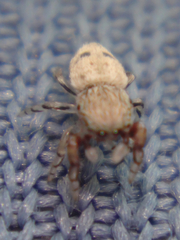European garden spider
Araneus diadematus
Arachnida Araneus diadematus, commonly known as the European Garden Spider or the Cross Orb-Weaver, is a species of orb-weaving spider frequently found across Europe, including the Comunidad Valenciana.
This spider is easily recognized by the distinctive white cross on its abdomen, which is a feature of its common names. Below is a detailed look at its characteristics:
- Appearance: The Araneus diadematus has a bulbous abdomen with a unique cross pattern. Its color ranges from light yellow to dark greyish-brown, depending on its specific habitat and diet. Both coloration and the cross pattern help in blending with its surroundings, serving as camouflage.
- Size: Females are larger than males, with females measuring between 10 to 20 millimeters and males from 5 to 13 millimeters. This sexual dimorphism is common in the spider world.
- Habitat: This species thrives in a variety of environments, from gardens and forests to meadows and urban areas. In the Comunidad Valenciana, it's often seen in gardens and areas with abundant vegetation.
- Web: A master at web construction, it builds large, wheel-shaped webs, often found suspended between shrubs, trees, or man-made structures. It uses its web to entrap flying insects, which constitute its primary diet.
- Behavior: The Araneus diadematus is primarily nocturnal, spending its daylight hours hidden in nearby foliage or retreats constructed from silk, and becoming active at night to repair its web or capture prey.
- Reproduction: During the late summer to autumn, the female lays eggs, which she wraps in a silk sac. In the Comunidad Valenciana, this can be observed in local gardens and natural landscapes.
This spider plays a crucial role in controlling insect populations, making it a beneficial presence in gardens and natural ecosystems. For those studying or simply enjoying the biodiversity of the Comunidad Valenciana, the Araneus diadematus is a fascinating and vital species to observe.







